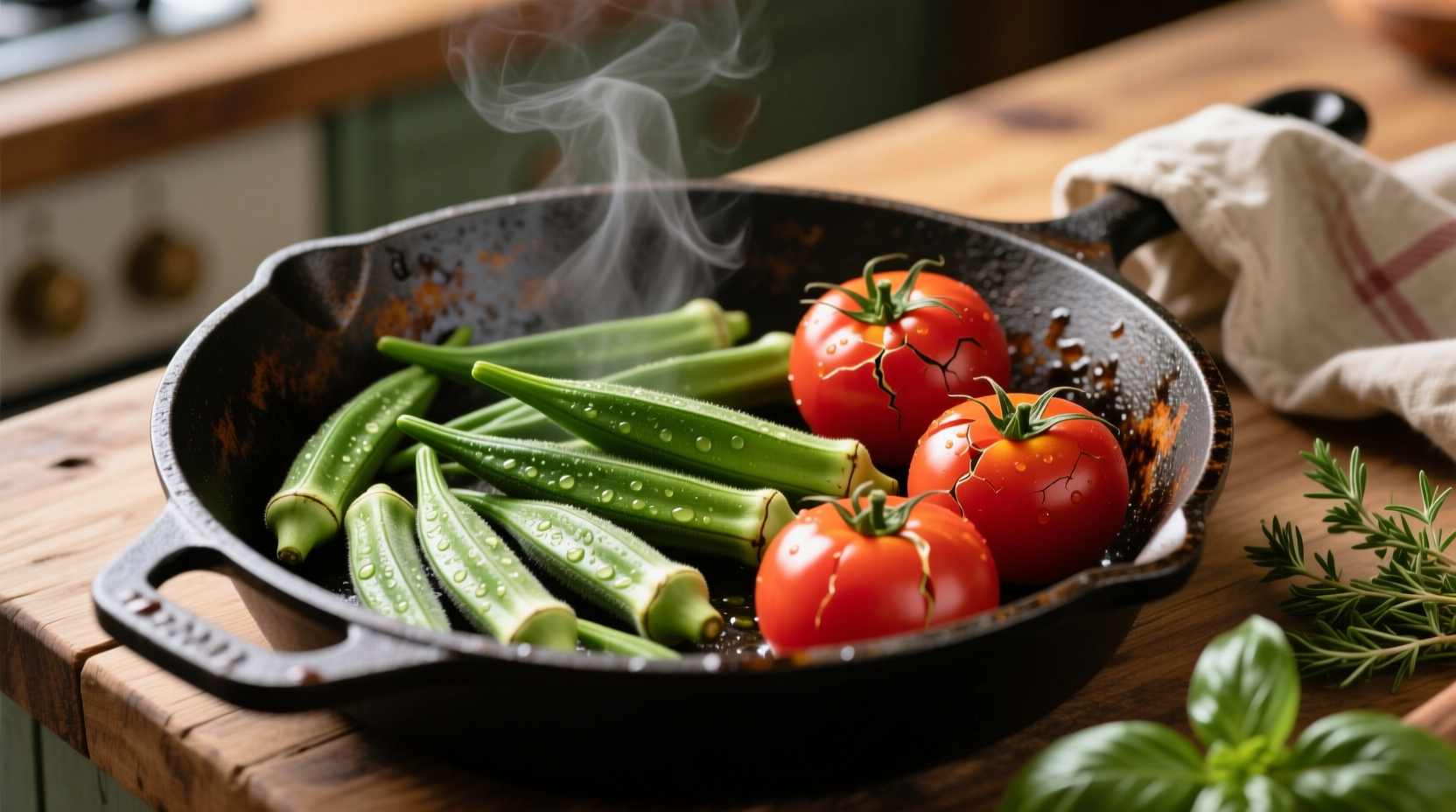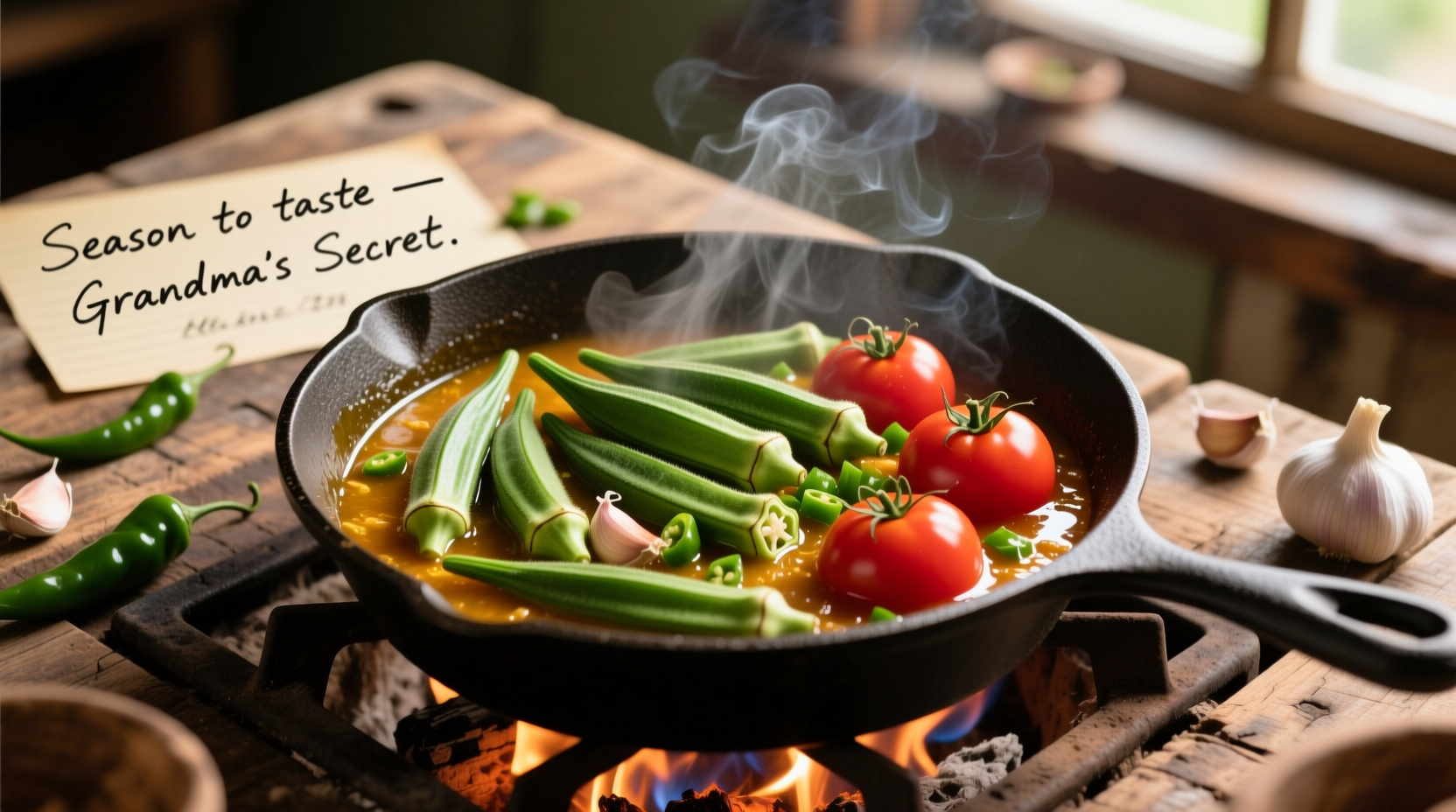Okra and tomatoes form one of the most scientifically harmonious vegetable pairings in global cuisine. The acidity in tomatoes counteracts okra's mucilage, creating a texture-rich stew that's been perfected across Southern US, West African, and Caribbean cooking traditions for centuries. This guide reveals the precise techniques professional chefs use to transform these humble ingredients into a dish worthy of any dinner table.
The Science Behind Perfect Okra and Tomato Harmony
Understanding why okra and tomatoes work so well together begins with food chemistry. Okra contains soluble fiber that creates viscosity when heated, while tomatoes provide citric and malic acids that break down this mucilage. According to USDA Food Safety and Inspection Service research, maintaining a pH below 4.6 significantly reduces sliminess while preserving okra's structural integrity (USDA FSIS, 2023).
| Preparation Method | Texture Result | Time Required |
|---|---|---|
| Raw okra chopped & added directly | Excessively slimy | Immediate |
| Dry-roasted before adding | Firm with slight bite | 8-10 minutes |
| Marinated in vinegar 15 minutes | Crisp-tender texture | 15 minutes |
Essential Ingredients Selection Guide
Not all okra and tomatoes perform equally in this classic combination. For optimal results:
- Okra selection: Choose pods under 4 inches long with vibrant green color and no brown spots. Smaller pods contain less mucilage.
- Tomato varieties: Roma tomatoes provide ideal acidity and fleshiness, while vine-ripened offer sweeter notes for balanced flavor profiles.
- Acid component: 2 tablespoons of apple cider vinegar or lemon juice added during cooking prevents sliminess better than tomatoes alone.

Step-by-Step Cooking Process
Follow this chef-tested sequence to achieve perfect texture and flavor integration:
- Prep okra properly: Trim ends without cutting into pod, slice crosswise into 1/2-inch pieces. Toss with 1 tbsp cornmeal and let sit 10 minutes to absorb surface moisture.
- Dry roast technique: Heat cast iron skillet over medium-high. Add okra in single layer without oil and roast 5-7 minutes until edges brown, stirring once.
- Build flavor foundation: Add 1 chopped onion and 3 minced garlic cloves to skillet, cooking until translucent (4 minutes).
- Tomato integration: Stir in 2 cups diced tomatoes, 1 diced bell pepper, 1 tsp smoked paprika, and 1/2 tsp cayenne. Simmer 15 minutes until tomatoes break down.
- Final seasoning: Add 2 tbsp apple cider vinegar, salt to taste, and fresh herbs. Simmer 5 more minutes before serving.
Contextual Application Guide
This versatile recipe adapts beautifully to different culinary contexts but has specific limitations:
- Best applications: Served over rice as main dish, as side with grilled proteins, or as base for shrimp addition (common in Creole cuisine)
- Seasonal considerations: Peak summer tomatoes require less cooking time; winter tomatoes benefit from 1/4 cup tomato paste for depth
- Dietary adaptations: Naturally vegan and gluten-free; for keto version, reduce tomatoes by 50% and increase okra proportion
- Texture warning: Avoid overcooking okra beyond 20 minutes total or it will become mushy regardless of preparation method
Nutritional Powerhouse Analysis
According to USDA FoodData Central, one serving (1.5 cups) of this okra and tomato preparation delivers remarkable nutritional benefits (USDA FoodData Central, 2024):
- 120 calories with 5g dietary fiber (20% daily value)
- 100% of daily vitamin C needs from tomatoes
- Significant potassium and magnesium from okra
- Natural folate content supports cellular health
The combination creates a synergistic effect where lycopene from tomatoes becomes more bioavailable when cooked with the healthy fats naturally present in okra.
Common Problems and Professional Solutions
Even experienced cooks encounter issues with okra and tomato recipes. Here's how to troubleshoot:
- Slimy texture: Always dry-roast okra first or marinate in acid before cooking. Never add raw okra directly to liquid.
- Bland flavor: Boost umami with 1 tsp fish sauce (even in vegetarian versions) or 2 chopped anchovies during cooking.
- Excess liquid: If stew becomes too watery, remove lid and increase heat for final 5 minutes of cooking.
- Bitter notes: Balance with 1 tsp honey or 1/4 cup coconut milk stirred in at the end.
Traditional Variations Across Cultures
This basic combination has evolved distinct regional expressions:
- Gumbo tradition: In Louisiana, okra serves as thickener for tomato-based seafood gumbos, often with the "holy trinity" of onions, celery, and bell peppers
- West African stew: Nigerian okra soup features tomatoes, palm oil, and smoked fish for deep umami notes
- Indian bhindi: Spiced with turmeric and mustard seeds, tomatoes added later in cooking for tangy contrast
- Caribbean style: Coconut milk and Scotch bonnet peppers create a tropical variation popular in Trinidadian cooking
Serving Recommendations
Maximize your okra and tomato creation with these professional pairing suggestions:
- Traditional: Over steamed white rice with a side of cornbread
- Modern twist: As filling for empanadas or stuffed bell peppers
- Breakfast adaptation: Top with poached eggs for a hearty morning meal
- Cool climate version: Add 1/2 cup cooked black-eyed peas for extra heartiness











 浙公网安备
33010002000092号
浙公网安备
33010002000092号 浙B2-20120091-4
浙B2-20120091-4